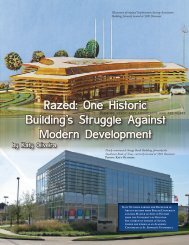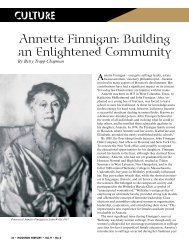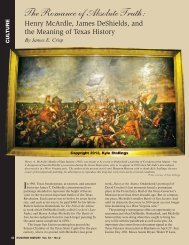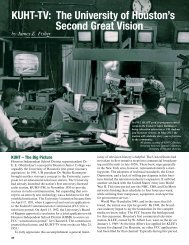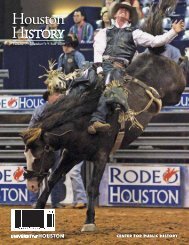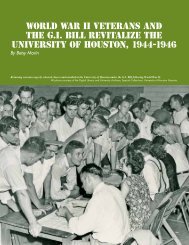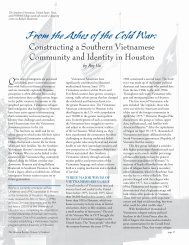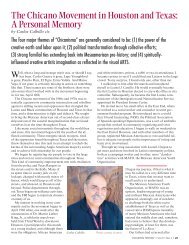You also want an ePaper? Increase the reach of your titles
YUMPU automatically turns print PDFs into web optimized ePapers that Google loves.
ecause I wasn’t very old and . . . I had matured a little bitin the service which really helped. So when I came back Ithought I was better prepared to coach and teach. 11The job offer as an assistant coach that he received before hisinduction was still waiting for him at Buena Vista High School.In retrospect, Tellez’s post-military career consisted of a seriesof what some may label “lucky breaks” with regard to his mentorsand the venues where he developed his coaching style. Itverified what the erudite Tiki Barber, a former All-Pro runningback for the New York Giants, said in a television interview,“Luck is where preparation meets opportunity.” In 1961, Tellezbecame head coach at Fullerton when his predecessor took aposition at the University of California at Los Angeles (UCLA).Eight years later, he offered Tellez the job of assistant coach,which Tellez accepted and held for nine years from 1968 to1976. In the last year, he assistedanother legendary head coach,Dick Vermeil. That year wasparticularly memorable becauseUCLA went to the Rose Bowland beat the highly-favored OhioState Buckeyes—a team thathad come through the seasonundefeated—by a score of23-10. It also expanded Tellez’sexperience to be working underVermeil, who became one of the NFL’s most respected andoutstanding coaches. 12Soon thereafter, Tellez dreamed of becoming a head coachbecause he wanted to apply his own philosophies to athletictraining. The idea of “biomechanical” techniques had emergedin the 1960s and 1970s, and Tellez became a disciple, eager toincorporate it into his coaching style. This interactive techniquerequires that the athlete, schooled in the traditional mechanicsof sports, becomes a knowledgeable part of its application.Tellez detailed the importance of his technique:There has to be biomechanical reasons why you doeverything [in sports]….you don’t just put the kids intoblocks and tell them ‘go’…. I had to give a reason tothose athletes…why I wanted them to do things [in themanner I was telling them to do it]. . . If you explainthat to kids, they learn quicker and they get better faster.They understand why and that is what you practice andthat is what you do at the meet. . . . To me that’s the bigchallenge – practice this way because it’s correct, now goto the meet and do the same thing.Gravity works on all bodies in the same way but we tryto overcome gravity in different ways in different events.In the throwing events like the javelin, the shot put, andeven throwing a baseball, all share a surprisingly similarbiomechanics. It is the same thing in running — there arenot ten ways to sprint, there is only one way to run fast. 13As laymen most of us imagine that sprinters line up in frontof some wooden blocks pre-positioned along a white line; thenat the sound of the starter gun, they run as fast as they cantoward the tape (the finish line) 100 meters away, and the firstone to the tape wins. That captures, to be sure, the essence ofthe event, but biomechanical techniques elevate the sprinter’s16 Vol. 6, No. 3–Sports“...there are notten ways to sprint,there is only one wayto run fast.”natural ability by allowing him or her to run at peak efficiency.Working on his master’s degree at Chapman College, Tellezmeticulously studied the movements of an athlete as he or sheperformed his or her respective event. The point was to isolateeach significant motion from the moment the sprinter pushed offthe blocks until he or she crossed the finish line. To do so, Tellezset up three cameras—back, side, and top—and simultaneouslyfilmed an athlete throwing the hammer. He then did a segmentalanalysis of the film that had recorded the movements at the rateof sixty-four frames per second. This scrupulous study allowedhim to note the interplay of the athlete’s velocities of movements,the angles of release, and rotational movements.You could see exactly what the foot was doing, what thearms were doing, and what the body was doing relativeto itself. . . . you have three different views so you can findout very quickly how thehuman body works. . . . I didmy own analysis using thissame technique I used inmy master’s thesis at everyevent during my career atUCLA and UH buildingmodels of different eventsand how they should becoached; what they looklike, the biomechanics ofeach, what they feel like, and a vocabulary for each,which I used in order to properly teach them.Later, a friend had an airplane camera that could shoot600 frames per second, which we used by developingstrips of film with fifteen frames and after looking slowlyat these strips you can observe even more detail of howthe human body works. If you don’t do segmental analysisand watch films frame by frame, you are going to miss alot. 14What did Tellez discover in this segmental analysis thatcontributed to his philosophy of coaching track? In his essay,Sprinting: a Biomechanical Approach, he writes:World class male sprinters stride approximately fortythreetimes during a 100 meter race. If a mechanicalerror costs one-one thousandth of a second per stride,the total cost is .043 seconds at the finish line. How canone be an efficient sprinter, the answer lies in scientificprinciples. . . . Kinesiology, the study of movement,dictates how a sprinter should move. Contributing tothe study of movement is the discipline of biomechanics,which refers to the engineering of the body and laws ofphysics governing it. While referencing laws of physics,kinesiology and biomechanics view the body as a unifiedsystem of interdependent parts, an approach necessary forproper analysis. 15This seemingly trivial bit of knowledge appears to be of littleimportance; however, in a sport where hundredths of a secondmean the difference between victory and defeat this representsa treasure trove of knowledge and a major contribution to thescience of coaching.In 1975, Tellez arrived at a crossroads in his coaching careerwhen two interesting positions opened up: training coach with



